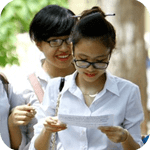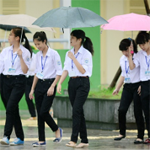Bộ đề thi thử THPT Quốc gia năm 2017 môn Tiếng Anh trường THPT Chu Văn An, Yên Bái (16 đề), Nhằm giúp các bạn ôn tập và chuẩn bị tốt nhất cho kỳ thi tốt nghiệp THPT
Để chuẩn bị cho kì thi THPT Quốc gia môn Tiếng Anh năm 2017 sắp tới đạt kết quả tốt nhất, Tài Liệu Học Thi xin giới thiệu đến các bạn Bộ đề thi thử THPT Quốc gia năm 2017 môn Tiếng Anh trường THPT Chu Văn An, Yên Bái CÓ ĐÁP ÁN (16 đề). Việc luyện tập và làm quen với các dạng đề thi sẽ giúp các em củng cố lại kiến thức và tích lũy kinh nghiệm giải đề thi đạt kết quả cao nhất. Chúc các bạn ôn thi tốt!
Bộ đề thi thử THPT Quốc gia năm 2017 môn Tiếng Anh CÓ ĐÁP ÁN – Số 5
Đề thi thử THPT Quốc gia năm 2017 môn Tiếng Anh trường Đại học Ngoại Thương, Hà Nội
Đề thi thử THPT Quốc gia năm 2017 môn Tiếng Anh trường Đại học Ngoại Thương (Lần 2)
Đề thi thử THPT Quốc gia năm 2017 môn Tiếng Anh trường THPT Chu Văn An, Yên Bái CÓ ĐÁP ÁN (1)
Mark the letter A, B, C, or D on your answer sheet to indicate the word whose underlined part differs from the other three in pronunciation in each of the following questions.
Question 1: A. lunch B. kitchen C. technology D. purchase
Question 1: A. news B. songs C. feelings D. delights
Mark the letter A, B, C, or D on your answer sheet to indicate the word that differs from the other three in the position of primary stress in each of the following questions.
Question 3. A. intelligent B. calculator C. impossible D. American
Question 4. A. eradicate B. continental C. popularity D. beneficial
Mark the letter A, B, C, or D on your answer sheet to indicate the correct answer to each of the following questions.
Question 8. Some scientists say that it is still not too late to minimize the effects of climate change________ enough money and effort are invested in correct projects.
A. in case B. ao that C. even if D. provided that
Question 9. Having finished her degree, __________________.
A. she started to work for an international company B. It took her 2 years to find a good job
C. the students carried out many experiments D. her job came up to her expectation.
Question 10. _______________, and the lesson began.
A. In comes the teacher B. In came the teacher
C. In the teacher was coming D. In was coming the teacher
Question 11. The teacher was explaining the lesson slowly and clearly_____________.
A. to make his students to understand it B. in order that his students can understand it
C. so as to that his students could understand it D. so that his students could understand it
Question 12. After you’ve ______ your brother at the swimming pool. Could you do some shopping for me?
A. given up B. handed in C. dropped off D. passed out
Question 13. As my secretary will be away for a couple of days, would you be kind enough to ________ my correspondence?
A. play back B. bring off C. return to D. take care of
Question 14. ______________ his assistance in those days, I would not be so successful now.
A. Unless I had B. If there were not C. If it had not for D. Had it not been for
Question 15. The United States consists of fifty states, ______ has its own government.
A. each B. each of which C. each of them D. each of that
Question 16. Sue: “The lecturer was a tall thin man with white hair.”
Robert: “Then it ______have been Dr Fell because he is short and fat.”
A. must B. mustn’t C. shouldn’t D. can’t
Question 17. It is necessary that a life guard ___________ the swimming pool while the children are taking their swimming lessons.
A. monitors B. must monitor C. monitor D. can monitor
Question 18. If energy _________ inexpensive and unlimited, many things in the world would be different.
A. is B. will be C. would be D. were
Question 19. People________how to dye their clothes even before they knew how to read and write.
A. had known B. have known C. knew D. are known
Mark the letter A, B, C, or D on your answer sheet to indicate the most suitable response to complete each of the following exchanges.
Question 20. “………………………… ” – “Oh, That sounds interesting”
A. How are the cakes? B. What cakes do you like?
C. Would you like some cakes? D. What do you think about the cakes?
Question 21. Anne: “Make yourself at home. ” – John: “___________”
A. Yes, Can I help you? B. That’s very kind. Thank you
C. Thanks! Same to you D. Not at all. Don’t mention it
Mark the letter A, B, C, or D on your answer sheet to indicate the sentence that is closest in meaning to each of the following questions.
Question 26. Sam is twenty-two years old, and his sister is eleven.
A. Sam is twice as old as his sister. B. Sam’s sister is eleven years younger than him.
C. Sam is older than his sister two times. D. A and B are correct.
Question 27. ” Why don’t we ban the sale of alcohol at football matches,” said the man.
A. The man suggested that they would ban the sale of alcohol at football matches.
B. It was suggested that the sale of alcohol at football matches be banned by the man.
C. The man suggested that the sale of alcohol at football matches should be banned.
D. It was suggested that the man should ban the sale of alcohol at football matches.
Question 28. The boy said to his teacher, “I haven’t finished the assignment yet. I’m really sorry”.
A. The boy apologized to his teacher for not having finished the assignment.
B. The boy apologized his teacher for not having finished the assignment.
C. The boy said sorry to his teacher for not having finished the assignment.
D. The boy apologized to his teacher for having not finished the assignment.
Mark the letter A, B, C, or D on your answer sheet to indicate the sentence that best combines each pair of sentences in the following questions.
Question 29. He had spent all his money. He decided to go home and ask his father for a job.
A. Spent all his money, he decided to go home and ask his father for a job.
B. Having spent all his money, he decided to go home and ask his father for a job.
C. In spite of having spent all his money, he decided to go home and ask his father for a job.
D. Deciding to go home and ask his father for a job. he had spent all his money.
Question 30. He may seem friendly. He’s not to be trusted.
A. However he seems friendly, he’s not to be trusted.
B. Friendly may he seem, he’s not to be trusted.
C. No matter friendly he seems, he’s not to be trusted.
D. Friendly though he may seem, he’s not to be trusted.
Read the following passage and mark the letter A, B, C, or D on your answer sheet to indicate the correct word or phrase that best fits each of the numbered blanks from 31 to 35.
From the next year, every student in their final rear at our school will study for a compulsory Diploma of Practical Achievement. This will be in addition to the normal examinations. Up to now, the course has been optional, but from now on every student must (31)_________it.
The aim is to (32)__________ students with “life skills”, which the Diploma divides into eight categories. These cover a range of things relevant to life beyond school, from sending an e-mail to giving presentation to an audience. Under the heading “survival”, (33)_______, students can learn car mainternance, first aid and cooking. We have discovered that many students cannot do simple things such as mend a puncture or boil an egg. At the other extreme, the Diploma includes such things as how to design a webpage and how to cope if someone has a heart attack. It has been called a ” Diploma in Common Sense”.
On the course, students will not be taught in the traditional (34)__________, but rather will be guided and encouraged to do things for themselves. This is above all a practical “hand-on” course. To a greater or lesser extent, good schools have always tried to (35)__________these skills. Unfortunately, students have not always shown much interest because such skills are not directly related to passing exams for higher education. We hope this will change now that we have a proper course that will lead to a recognised diploma.
Question 31. A. pick B. make C. adopt D. take
Question 32. A. equip B. give C. offer D. donate
Question 33. A. as a result B. therefore C. otherwise D. for example
Question 34. A. means B. approach C. route D. way
Question 35. A. grow B. develop C. make D. do
Read the following passage and mark the letter A, B, C, or D on your answer sheet to indicate the correct answer to each of the questions from 36 to 42.
Archaeological records ― paintings, drawings, and carvings of humans engaged in activities involving the use of hands ― indicate that humans have been predominantly right-handed for more than 5,000 years. In ancient Egyptian artwork, for example, the right-hand is depicted as the dominant one in about 90percent of the examples. Fracture or wear patterns on tools also indicate that a majority of ancient people were right-handed.
Cro-Magnon cave paintings some 27,000years old commonly show outlines of human hands made by placing one hand against the cave wall and applying paint with the other. Children today make similar outlines of their hands with crayons on paper. With few exceptions, left hands of Cro-Magnons are displayed on cave walls, indicating that the paintings were usually done by right-handers.
Anthropological evidence pushes the record of handedness in early human ancestors back to at least 1.4 million years ago. One important line of evidence comes from flaking patterns of stone cores used in toolmaking: implements flaked with a clockwise motion (indicating a right-handed toolmaker) can be distinguished from those flaked with a counter-clockwise rotation (indicating a left-handed toolmaker).
Even scratches found on fossil human teeth offer clues. Ancient humans are thought to have cut meat into strips by holding it between their teeth and slicing it with stone knives, as do the present-day Inuit. Occasionally the knives slip and leave scratches on the users’ teeth. Scratches made with a left-to-right stroke direction (by right-handers) are more common than scratches in the opposite direction (made by left-handers).
Still other evidence comes from cranial morphology: scientists think that physical differences between the right and left sides of the interior of the skull indicate subtle physical differences between the two sides of the brain. The variation between the hemispheres corresponds to which side of the body is used to perform specific activities. Such studies, as well as studies of tool use, indicate that right- or left-sided dominance is not exclusive to modern Homo sapiens. Populations of Neanderthals, such as Homo erectus and Homo habilis,seem to have been predominantly right-handed, as we are.
Đề thi thử THPT Quốc gia năm 2017 môn Tiếng Anh trường THPT Chu Văn An, Yên Bái CÓ ĐÁP ÁN (2)
Mark the letter A, B, C, or D on your answer sheet to indicate the word whose underlined part differs from the other three in pronunciation in each of the following questions.
Question 1: A. news B. songs C. feelings D. delights
Question 2: A. determine B. together C. repeat D. report
Mark the letter A, B, C, or D on your answer sheet to indicate the word that differs from the other three in the position of primary stress in each of the following questions.
Question 3: A. answer B. complain C. listen D. travel
Question 4: A. information B. nationality C. engineering D. biology
Mark the letter A, B, C, or D on your answer sheet to indicate the correct answer to each of the following questions.
Question 8: We _______ today and I got into trouble because I hadn’t done it.
A. were checked our homework B. have our homework checking
C. had checked our homework D. had our homework checked
Question 9: Ancient Egyptians mummified the dead bodies through the use of chemicals, _______ ancient Peruvians did through natural processes.
A. because C. whether or not C. whereas D. even though
Question 10: Please cut my hair _______ the style in this magazine.
A. the same length like B. the same length as C. the same long like D. the same long as
Question 11: He never seems to be serious when talking with me. He is always trying to ________.
A. cut my hair B. pull my leg C. look into my eyes D. pay through the nose
Question 12: _______, he would have been able to pass the exam.
A. Studying more B. Had he studied more C. If he studied more D. If he were studying more
Question 13: They seemed to be _______ to the criticism and just carried on as before.
A. disinterested B. sensitive C. uncaring D. indifferent
Question 14: _________with the size of the whole Earth, the highest mountains do not seem high at all.
A. Compare them B. A comparison C. If you compare D. When compared
Question 15. On being told about her sack, _________________
A. her boss felt sorry for Mary B. Mary felt sorry for her boss
C. Mary’s face turned pale D. Mary was shocked
Question 16: When I got my case back, it had been damaged _______ repair.
A. over B. further C. above D. beyond
Question 17: __________that she burst into tears.
A. So angry was she B. Such her anger C. She was so anger D. Her anger was so
Question 18: We regret to tell you that the materials you ordered are _______.
A. out of reach B. out of practice C. out of stock D. out of work
Question 19: Lucy was late for school this morning because the alarm didn’t _____________as usual.
A. take off B. go off C. get off D. ring off
Mark the letter A, B, C, or D on your answer sheet to indicate the most suitable response to complete each of the following exchanges.
Question 20: – “I think we should recycle these bags. It will help protect the environment.”
– “_______”
A. Never mind B. I can’t agree with you more
C. You can say that again D. It’s rubbish. We shouldn’t use it.
Question 21: Mark: -“_______” Helen: “Oh, thank you. I just got it yesterday.”
A. What a beautiful dress you have on! B. How a beautiful dress you’re wearing!
C. You’ve just bought this beautiful dress, haven’t you? D. When have you got this beautiful dress?
Mark the letter A, B, C, or D on your answer sheet to indicate the sentence that is closest in meaning to each of the following questions.
Question 26: The meeting was put off because of pressure of time.
A. The meeting started earlier because people wanted to leave early.
B. There was not enough time to hold the meeting.
C. The meeting was planned to start late because of time pressure.
D. The meeting lasted much longer than usual.
Question 27: “I’m sorry I made a mistake.” said he.
A. He blamed her for making a mistake.
B. He said he had made a mistake.
C. He apologized for making a mistake.
D. He admitted that he had made a mistake.
Question 28: We would have had a better time at the party if we had known some of the other guests.
A. We guess we had a better time at the party than the other people.
B. We had a good time with the guests at the party.
C. We knew none of the people at the party.
D. We knew almost every person at the party.
Mark the letter A, B, C, or D on your answer sheet to indicate the sentence that best combines each pair of sentences in the following questions.
Question 29: The new restaurant looks good. However, it seems to have few customers.
A. In order to get more business, the new restaurant should improve its appearance.
B. The new restaurant would have more customers if it looked better.
C. If it had a few more customers, the new restaurant would look better.
D. In spite of its appearance, the new restaurant does not appear to attract much business.
Question 30: We chose to find a place for the night. We found the bad weather very inconvenient.
A. Bad weather was approaching, so we started to look for a place to stay.
B. The bad weather prevented us from driving any further.
C. Seeing that the bad weather had set in, we decided to find somewhere to spend the night.
D. Because the climate was so severe, we were worried about what we’d do at night.
Read the following passage and mark the letter A, B, C, or D on your answer sheet to indicate the correct word or phrase that best fits each of the numbered blanks from 31 to 35.
The first question we might ask is: What can you learn in college that will help you in being an employee? The school teach a (36) ____ many things of value to the future accountant, doctor or electrician. Do they also teach anything of value to the future employee? Yes, they teach the one thing that it is perhaps most valuable for the future employee to know. But very few students bother to learn it. This basic is the skill ability to organize and express ideas in writing and in speaking. This means that your success as an employee will depend on your ability to communicate with people and to present your own thoughts and ideas to them so they will (39) _____ understand what you are driving at and be persuaded.
Of course, skill in expression is not enough by itself. You must have something to say in the first place. The effectiveness of your job depends (41) ____ your ability to make other people understand your work as they do on the quality of the work itself.
Expressing one’s thoughts is one skill that the school can really teach. The foundations for skill in expression have to be laid early: an interest in and an ear (44) ___ language; experience in organizing ideas and data, in brushing aside the irrelevant, and above all the habit of verbal expression. If you do not lay these foundations during your school years, you may never have an opportunity again.
Question 31: A. great B. far C. large D. lost
Question 32: A. learning B. to learn C. with learning D. learn
Question 33: A. not B. as well C. both D. either
Question 35: A. on most B. most on C. much on D. on much
Question 35 A. by B. in C. for D. of
Read the following passage and mark the letter A, B, C, or D on your answer sheet to indicate the correct answer to each of the questions from 36 to 42.
It takes a long time to raise a family of owlets, so the great horned owl begins early in the year. In January and February, or as late as March in the North, the male calls to the female with a resonant hoot. The female is larger than the male. She sometimes reaches a body length of twenty-two to twenty-four inches, with a wingspread up to fifty inches. To impress her, the male does a strange courtship dance. He bobs. He bows. He ruffles his feathers and hops around with an important air. He flutters from limb to limb and makes flying sorties into the air. Sometimes he returns with an offering of food. They share the repast, after which she joins the dance, hopping and bobbing about as though keeping time to the beat of an inner drum.
Owls are poor home builders. They prefer to nest in a large hollow in a tree or even to occupy the deserted nest of a hawk or crow. These structures are large and rough, built of sticks and bark and lined with leaves and feathers. Sometimes owls nest on a rocky ledge, or even on the bare ground. The mother lays two or three round, dull white eggs. Then she stoically settles herself on the nest and spreads her feather skirts about her to protect her precious charges from snow and cold.
It is five weeks before the first downy white owlet pecks its way out of the shell. As the young birds feather out, they look like wise old men with their wide eyes and quizzical expressions. They clamor for food and keep the parents busy supplying mice, squirrels, rabbits, crayfish, and beetles. Later in the season baby crows are taken. Migrating songsters, waterfowl, and game birds all fall prey to the hungry family. It is nearly ten weeks before fledglings leave the nest to search for their own food. The parent birds weary of family life by November and drive the young owls away to establish hunting ranges of their own.












